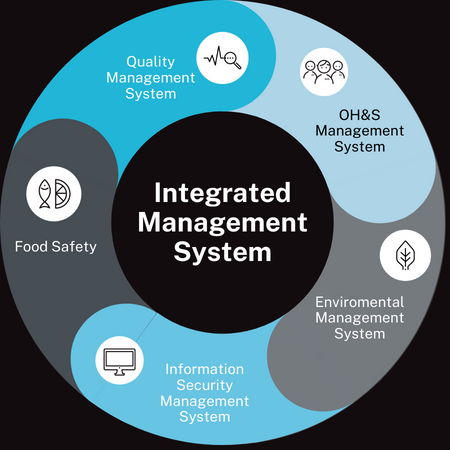Elevating Workplace Safety
In recognition of World Day for Safety and Health at Work, the global call is for organisations to shift their focus from merely achieving compliance to genuinely committing to elevated standards in workplace health and safety. The ISO 45001 Occupational Health and Safety Management System standard offers an exceptional framework for managing occupational health and safety (OHS) risks and opportunities. True safety culture begins with safety compliance and extends beyond the work environment into the everyday world of your employees.
Designing Occupational Health and Safety with the ISO 45001 Framework
Safety matters at every moment in your organisation. That’s why ISO 45001 is designed to provide organisations with a robust structure for managing OHS risks, ensuring a safe and healthy workplace, and systematically protecting the well-being of employees from both physical and mental health hazards.
This standard emphasises a proactive approach to minimising safety risks and advocating for a preventative mindset rather than a reactive one. It champions the idea that a systematic approach to evaluating compliance requirements reassures stakeholders of an organisation’s dedication to workplace safety.
Beyond compliance: To safety improvement
Adopting safe work practices at every turn with the ISO 45001 standard is more than meeting legal obligations: it’s a testament to an organisation’s commitment to improving occupational health and safety performance.
Integrating safety into your work practices enhances your business brand and demonstrates to customers, suppliers, employees, and the community at large that you are engaged in making meaningful improvements. Such commitment can significantly reduce operational downtime by eliminating hazards and minimising OHS risks, safeguarding employees’ physical and mental health. Consequently, this leads to improved worker engagement, enhanced organisational reputation, and better business performance overall.
Why implement ISO 45001?
- Meet your compliance requirements: Implementing an OHS management system (OHSMS) based on ISO 45001 standards ensures that an organisation can systematically meet its compliance obligations, reassuring stakeholders of its dedication to maintaining a safe work environment.
- Demonstrate your commitment to safety improvement: ISO 45001 places emphasis on taking proactive measures to enhance workplace safety, offering a clear demonstration of an organisation’s commitment to its employees’ well-being and overall safety performance.
- Reduce operational downtime: By prioritising the elimination of hazards and minimising risks, companies can safeguard against operational disruptions. The best news is that this reduces costs associated with downtime.
- Improved employee morale: A safe workplace boosts employee morale. Workers feel valued and protected, which, in turn, fosters loyalty and can significantly impact productivity and job satisfaction.
- Lower insurance costs: With reduced workplace incidents comes the potential for lower insurance premiums. Demonstrating an effectively implemented OHSMS can position an organisation favourably when negotiating with insurance providers.
- Climate change action: With the latest 2024 amendments, implementing OHS practices with ISO 45001 also means adopting a long-term and holistic view. The amendment reflects a forward-looking approach – by integrating climate action into the OHS Management Systems framework – organisations can identify their impact on health and safety of people within their organisation but also the community at large.


Safety: Developing a holistic approach
ISO 45001:2018 is often implemented together with ISO 14001 for Environmental Management and ISO 9001 for Quality Management as a triple certification.
By adding ISO 27001 for Information Management System or any of the relevant Food safety Standards demonstrates a commitment to a fully integrated management system and facilities a holistic approach to organisational management systems that prioritises efficiency, safety, data integrity and sustainability.
Completing the commitment with training
To foster a culture of safety at every level of your business, safety training is crucial. Training internal employees on safety culture for ISO 45001 is a crucial step in embracing the standard’s full potential for enhancing workplace safety. By educating employees about safety principles and practices, you can foster a culture of safety that permeates every level of your business.
Taking it to the next level: Internal Auditors
There are a variety of courses at every level to advance your team’s safety knowledge, experience and confidence. Having highly skilled team members who can help to maintain your safety culture is best practice. You can upskill your team to become Internal Auditors, which ensures that employees are well-informed about the safety principles of ISO 450012 and also the importance of identifying and mitigating risks that can empower them to take proactive steps towards safeguarding their own health and that of their colleagues.
Additionally, well-trained employees can contribute significantly to the continuous improvement of occupational health and safety management systems, making the workplace not just safer but also more efficient and harmonious. Investing in the training of internal employees on ISO 45001 thereby elevates an organisation’s commitment to safety from compliance to a deeply embedded value, benefiting all stakeholders.
Begin the commitment today!
The transition from compliance to commitment in workplace safety is a strategic move that communicates to all stakeholders—an organisations’ serious stance on protecting their most valuable asset: their employees. This World Day for Safety and Health at Work, may every organisation take a moment to reflect not just on the compliance checkboxes but on the deeper commitment to creating a work environment where safety is embedded in every aspect of the organisational culture.
Adopting a safety culture in your organisation with ISO 45001 presents an excellent opportunity for businesses to lead in this regard, leveraging its framework not just for compliance, but as a steppingstone towards fostering an inclusive, safe, and health-conscious workplace. Implementing an effective OHS management system is not just a business necessity but a moral imperative that benefits everyone involved.

